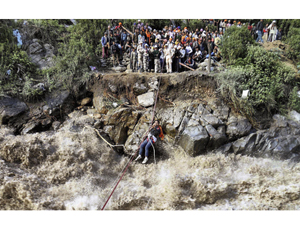06/24/2013

AP
Indo-Tibetan border police use a rope to rescue stranded pilgrims on June 20.
While the Himalayan disaster has exposed weaknesses in emergency management policies, the need for India to adopt a sustainable and integrated infrastructure is as urgent as ever, says local environmentalist Anupam Nautiyal. At least 10 hydroelectric power projects have been damaged in the region due to heavy silt and debris.
Large dams are especially vulnerable, says Himanshu Thakkar, coordinator of the South Asia Network on Dams, Rivers and People (SANDRP). Some 600 hydropower projects, which required blasting, underground tunnels, roads, encroachments of riverbeds by buildings and deforestation, could have worsened the impact of the flash floods in the state.
"We do not have credible environmental impact assessments of infrastructure projects on these highly ecologically sensitive areas," Thakkar says. "Neither is there any reliable mechanism to assure compliance with environmental regulations."
Since June 15, 80,000 people have been evacuated as heavy rains hit during the peak tourist season, and many of the tourists headed to four pilgrimage shrines in the area. A fast-moving rescue operation—carried out by the military using light helicopters— has coincided with a challenging rebuilding effort to fix washed-out roads and bridges.
Engineers with the Border Roads Organization (BRO) have constructed makeshift roads and bridges to enable people to cross on foot.
"We cut into hills to make a trail," says Brig. VSK Kataria, BRO's deputy director general of technical planning. "Since many bridges were washed away, we built Bailey bridges that have a modular design and can be assembled with minimal aid from heavy equipment." The portable bridges are "ideal for remote sites to handle heavy loads of machines and trucks," Kataria adds.
The area is familiar with such rapid bridge construction. A Bailey bridge that the Indian army built in Ladakh in 1982 is said to be the world's tallest, with an altitude of 5,602 m (18,379 ft). BRO works under India's Ministry of Defense, whose main role is to develop and maintain road infrastructure in the border areas.
"We're using logs in some places [for crossings] and steel panels of 10-foot length," Kataria says. "It's like a Meccano [erector set]—we keep adding."
Rebuilding the roads will take time. Two roads hit by the landslides—one 300 kilometers long and the other 150 km long—were connected using local materials, including stones and boulders to ensure light transport could run on them. Approximately 7 km of roads hit by landslides, including about 30 breaches spanning about 1.5 km total, is now under repair. More rebuilding will follow.
Nice blog and content posted in the blog seems very informative for Indian Himalayas.
ReplyDeleteThanks for sharing such useful information. Keep sharing in future....
Thanks for sharing such useful information . Keep sharing in future...
ReplyDelete